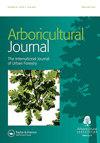对大叶金合欢(acacia mangium Willd.)和耳叶金合欢(acacia auriculiformis A. Cunn.)损伤茎中可能影响内部腐烂程度的机械损伤参数的研究。Benth交货)。
Q3 Agricultural and Biological Sciences
引用次数: 1
摘要
摘要:树木的机械损伤可导致早期腐烂和随后的树木早期移除。本研究评估了影响大叶金合欢(acacia mangium Willd.)和耳叶金合欢(acacia auriculiformis A. Cunn.)机械损伤茎内腐烂程度的六个因素。Benth交货)。本研究以电阻仪(Resistograph®)微钻对香港大埔工业园内的71株mangium和auriculiformis立标本进行了内部腐烂程度的测定。通过在三个位置垂直于每个茎的伤口表面钻孔来计算每个茎的直径与健全木材的比率。伤口深度是预测茎干内部腐烂程度的重要因素,伤口深度越大,内部腐烂程度越大,预测的变异率约为30%。茎部创面面积与木耳内腐程度的关系不显著,木耳内腐表现出较强的抗腐性。通过对立木腐烂的定量研究,可以用区域生长的方法建立一个新的木材腐烂过程模型。本文章由计算机程序翻译,如有差异,请以英文原文为准。
An investigation into mechanical wound parameters that may affect the extent of internal decay in wounded stems of big-leaved acacia (Acacia mangium Willd.) and ear-leaved acacia (Acacia auriculiformis A. Cunn. ex Benth.)
ABSTRACT Mechanical injuries to trees can cause an early onset of decay and subsequent early removal of trees. This study assessed six factors that might affect the extent of internal decay in mechanically wounded stems of big-leaved acacia (Acacia mangium Willd.) and ear-leaved acacia (Acacia auriculiformis A. Cunn. ex Benth.). The extent of internal decay was determined by using a Resistograph® microdrill on 71 standing specimens of A. mangium and A. auriculiformis in Tai Po Industrial Estate, Hong Kong. The ratio of sound wood to the diameter of each stem was calculated by drilling perpendicular to each stem wound’s surface at three locations. The wound’s depth was a significant factor in predicting the extent of internal stem decay, with greater depth of wounding relating to a greater extent of internal decay, predicting approximately 30% of the variation. The factor of stem wound area was not significantly associated with the severity of the internal decay in A. auriculiformis, which, from this analysis, exhibited more decay resistance than A. magnium. It is concluded that through quantitative research into decay in standing trees a new model for the progress of wood decay could be developed by using a region-growing approach.
求助全文
通过发布文献求助,成功后即可免费获取论文全文。
去求助
来源期刊

Arboricultural Journal
Agricultural and Biological Sciences-Agronomy and Crop Science
CiteScore
2.40
自引率
0.00%
发文量
28
期刊介绍:
The Arboricultural Journal is published and issued free to members* of the Arboricultural Association. It contains valuable technical, research and scientific information about all aspects of arboriculture.
 求助内容:
求助内容: 应助结果提醒方式:
应助结果提醒方式:


